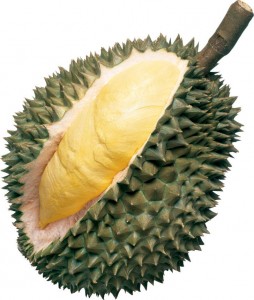 Durian (Durio zibethinus Murr.) is a distinctive Asian fruit. The tree reaches a height of 40 meters. Its bark is red-brown and peels off regularly. The trunk is buttressed. Its leaves are oval or lance-head-shaped and arranged alternately. The upper surface is smooth and glossy. The lower part is covered with scales and hairs. The flowers are whitish and greenish white. The fruit is green to brownish in color, shaped like a globe or egg.
Durian (Durio zibethinus Murr.) is a distinctive Asian fruit. The tree reaches a height of 40 meters. Its bark is red-brown and peels off regularly. The trunk is buttressed. Its leaves are oval or lance-head-shaped and arranged alternately. The upper surface is smooth and glossy. The lower part is covered with scales and hairs. The flowers are whitish and greenish white. The fruit is green to brownish in color, shaped like a globe or egg.
Adaptation
Durian is adapted to sandy loam and clay loam, with high organic matter, reasonably deep and slightly acidic soil (pH of 5.6).
Durian grows in lowland tropics in elevation up to 800 meters above sea level with optimum temperature of 25-35 0C and 80% relative humidity.
Recommended Varieties
1. Arancillo (ACC. 1497)
The tree reaches a height of 7-8 meters and has an intermediate to spreading growth habit. The ovoid, brownish green fruit weighs about 1,560 grams with Mimosa yellow, firm and creamy flesh. It has mild aroma. It is prolific and consistent, has excellent eating quality and bears off-season fruits.
2. Atabrine (DES 806)
The tree has spreading growth habit with simple, alternate, dark green oblong leaves. It has ellipsoidal, greenish yellow fruit with Naples yellow, smooth and firm flesh.
3. Mamer (DES 916)
Like other varieties, Mamer reaches about 7-8 meters in height. It has simple, alternate, dark green oblong leaves. Its fruit is ellipsoidal green and with flesh which is smooth and firm and Mimosa yellow in color.
4. Chanee (AC 2815)
The tree has a spreading growth habit. Its simple, oval-oblong leaves which are very dark green above and cinnamon colored beneath are arranged alternately. It has ovoid, green to greenish brown fruit and smooth and firm golden yellow flesh.
5. Monthong
The tree reaches a height of 8-9 meters and has ovoid green to greenish brown fruit with creamy yellow flesh. It has simple, alternate very dark green leaves which are linear-oblong in shape.
6. Oboza
The tree is strong with drooping branches and simple, alternate dark green, linear-oblong leaves. It has green fruit which is ellipsoidal in shape. The flesh is yellow in color and firm, soft and buttery.
7. Puyat
Like Oboza, Puyat is strong with drooping branches and has intermediate growth habit. However, it has cylindrical greenish brown fruit with chrome yellow, firm, soft and buttery flesh.
8. Lacson #1
The tree has spreading growth habit with simple, alternate, dark green oblong leaves. It has obovate, brownish green fruit with Areolin yellow, smooth and firm flesh.
Durian Production
Methods of Propagation
- Seed
- Cleft grafting
- Hypocoty grafting
- Epicotyl grafting
- Patch budding
Cultural Management
Land Preparation
- Clear and remove all stumps and grasses.
- Plow twice and harrow thrice to loosen the soil.
Distance of Planting
- 5 x 10 meters = 200 plants/ha.
- 8 x 8 meters = 156 plants/ha.
- 10 x 10 meters = 100 plants/ha.
Preparation of Holes and Planting
- Dig a cubical holes measuring 50-100 m wide and 50-100 cm deep for clay soil type.
- Remove the plastic bag and plant the seedling into the hole without breaking the ball of soil. Prune spiraled roots to enhance root branching.
- Plant young plants at their dormant stage.
- Cover the hole with soil-manure mixture and press gently the surface of the soil.
- Plant during rainy season.
Maintenance
- Provide shade to newly planted durian seedlings for a period of two weeks to a few months depending on weather condition to enable the plant to recover from transplanting shock and to shade it from strong sunlight.
- Apply as basal 50 grams (5 tbsp.) of complete fertilizer (14-14-14) or based on soil analysis and cover with thin layer of soil. Rate of application increases as tree matures.
- Grow seasonal crops between rows of durian before they become productive.
- Ring weeding should be done before fertilization.
- Prune/remove dead, broken or diseased branches and water shoots to obtain desired canopy shape to enhance production of fruits.
- Mulch the tree with rice straw, dried leaves, cut grasses, or coconut husk during dry season.
Harvesting and Post Harvest Management
A well cared durian tree starts bearing fruits as early as five years old. Durian fruits generally fall from the trees at night when already mature and ripe.
Hand picked fruits have longer shelf life of 5-7 days compared to 2-3 days for fallen fruits.
Maturity Indices
- The fruit is 106-108 days old from opening for local cultivars, 112,113 days old Chanee and 125 days old for Monthong.
- Change in color. Pericarp turns yellowish green or brown.
- A dull and hollow sound when tapped.
- Strong aroma.
- Very pliable spine.
- Very distinct suture.Sweet with dull characteristic durian flavor.